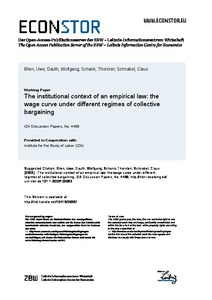The institutional context of an 'empirical law'. The wage curve under different regimes of collective bargaining
"The wage curve identified by Blanchflower and Oswald (1994) postulates that the wage level is a decreasing function of the regional unemployment rate. In testing this hypothesis, most empirical studies have not taken into account that differences in the institutional framework may have an impa...
| Main Authors: | , , , |
|---|---|
| Institution: | ETUI-European Trade Union Institute |
| Format: | TEXT |
| Language: | English |
| Published: |
Bonn
2009
IZA |
| Subjects: | |
| Online Access: | https://www.labourline.org/KENTIKA-19187925124919051079-The-institutional-context-of-a.htm |
| _version_ | 1771659901048717313 |
|---|---|
| author | Blien, Uwe Dauth, Wolfgang Schank, Thorsten Schnabel, Claus |
| author_facet | Blien, Uwe Dauth, Wolfgang Schank, Thorsten Schnabel, Claus |
| collection | Library items |
| description | "The wage curve identified by Blanchflower and Oswald (1994) postulates that the wage level is a decreasing function of the regional unemployment rate. In testing this hypothesis, most empirical studies have not taken into account that differences in the institutional framework may have an impact on the existence (or the slope) of a wage curve. Using a large-scale linked employer-employee data set for western Germany, this paper provides a first test of the relevance of different bargaining regimes and of works councils for the existence of a wage curve. In pooled regressions for the period 1998 to 2006 as well as in worker-level or plant-level fixed-effects estimations we obtain evidence for a wage curve for plants with a collective bargaining agreement at firm level. The point estimates for this group of plants are close to the -0.1 elasticity of wages with respect to unemployment postulated by Blanchflower and Oswald. In this regime, we also find that works councils dampen the adjustment of wages to the regional unemployment situation. In the other regimes of plants that either do not make use of collective contracts or apply sectoral agreements, we do not find a wage curve." |
| format | TEXT |
| geographic | Germany |
| id | 19187925124919051079_03e5b22c85a840eaa2e27c50fee7f948 |
| institution | ETUI-European Trade Union Institute |
| is_hierarchy_id | 19187925124919051079_03e5b22c85a840eaa2e27c50fee7f948 |
| is_hierarchy_title | The institutional context of an 'empirical law'. The wage curve under different regimes of collective bargaining |
| language | English |
| physical | 23 p. Digital |
| publishDate | 2009 |
| publisher | Bonn IZA |
| spellingShingle | Blien, Uwe Dauth, Wolfgang Schank, Thorsten Schnabel, Claus collective bargaining collective agreement statistics unemployment wage determination The institutional context of an 'empirical law'. The wage curve under different regimes of collective bargaining |
| thumbnail | https://www.labourline.org/Image_prev.jpg?Archive=116110293439 |
| title | The institutional context of an 'empirical law'. The wage curve under different regimes of collective bargaining |
| topic | collective bargaining collective agreement statistics unemployment wage determination |
| url | https://www.labourline.org/KENTIKA-19187925124919051079-The-institutional-context-of-a.htm |

